
6 Free Productivity Tools You Need Yesterday
SMBs need low-cost tools that offer dependability, productivity and a strong reputation for quality. Luckily, there’s no shortage of options.

Up-and-coming companies have a number of advantages over larger brands. Their niche expertise and white-glove customer service can outshine even the biggest competitor the market has to offer.
But without the right technology in place, prospects might default to the shinier, more reputable logos.
To earn (and keep) the attention of their customers, SMBs need low-cost tools that offer dependability, productivity and a strong reputation for quality. Luckily, there’s no shortage of options.
1. HubSpot for CRM

HubSpot’s Customer Platform is the all-in-one tool businesses need to drive growth. It combines engagement hubs that allow you to connect with your customers across every touch point, with a Smart CRM to unify data and deliver intelligent insights. Your entire team can work together on the customer platform to better connect with and serve your customers.
HubSpot’s customer platform analyzes sales activity, so sales teams can easily keep an eye on how all of the deals in their pipeline are moving along. Marketing can observe where and how visitors are converting into leads. And lastly, CS teams can manage all customer support tickets from one place.
How it helps SMB productivity
You need to know your customers to serve them better. Every time a customer needs to repeat who they are, why they’re contacting you and what they need, they’re having a negative and frustrating experience with your brand.
Instead, a CRM lets you store all of that customer information in one central place, where it’s instantly available to any team across your entire company. No one will need to waste time digging for data like purchase histories or prior communications during an email exchange or call.
Pricing
It’s easy to get started with HubSpot’s suite of free tools for marketing, sales, service, CMS and operations.
Smaller organizations should get plenty of mileage from HubSpot’s free offering, and no credit card is required to sign up. And as companies scale, HubSpot offers a solid Starter plan for $20/month.
2. Notion for internal documentation, workflows and collaboration
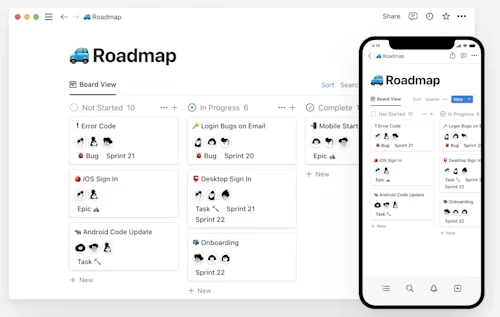
Notion is a highly flexible platform that can be used to organize nearly any kind of information. Teams use Notion as a knowledge base, content calendar, workflow library, note-taking space and even a project management tool.
It’s ideal for both rough, unpolished ideas, like notes from a brainstorming session, and for organizing mission-critical data, like payment processes. It’s like a virtual filing cabinet, or maybe a library—arranged so it’s easy to find exactly what you need.
How it helps SMB productivity
Disorganized information is an immediate productivity killer, especially for small and time-strapped teams. When teams waste time sifting through inboxes to find what they need—or even worse, go without it—they ignore important workflows and contextual information.
Instead, Notion stores all of the knowledge teams need to work at their best. People use it to house living documents, processes, policies, style guides and more in one central hub, which ultimately organizes it in a clear, intuitive way.
Notion also offers a huge library of templates for small businesses and startups, so it’s especially useful if you’re in growth mode.
Pricing
Notion’s free plan is a collaborative workspace for up to 10 guests. It offers basic page analytics, stores seven days of version history and boasts integrations with tools like GitHub and Slack.
As companies scale, Notion’s Plus and Business plans ($8 and $10 per user, per month respectively) can meet their changing needs.
3. Asana for project management
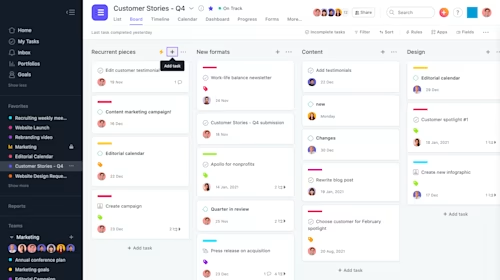
Asana is a comprehensive work management platform used across dozens of industries. Organizations use it to manage projects across functions like sales, marketing, product, operations and information technology.
Within Asana, users create tasks, which are easily broken down into subtasks. These are assigned to team members and given a timeline for completion. People can collaborate by commenting or directly on embedded documents.
Asana integrates with common work apps like Google Workspace and offers lots of automations to save users time. Native insights, like custom chart visualizations, give a big-picture view of how projects and campaigns are moving along.
If Notion is a filing cabinet, Asana is the actual office—a virtual space where work gets done.
How it helps SMB productivity
A work management platform like Asana reduces everyone’s cognitive load. People at SMBs wear so many hats, so with a tool like Asana, they don’t need to spend mental energy trying to remember what’s next on their to-do list or where certain projects stand in terms of progress and laddering up to broader goals.
Every team needs a system for staying organized. If people don’t know what’s happening, team members waste time asking what needs to be done instead of actually doing the work.
When that information is visible at a glance, they can focus on high-impact priorities.
Pricing
Asana’s free Basic plan is a well-rounded offer. Users get unlimited projects, tasks, storage, activities logged and comments. They’ll be able to view their project as a List, Board or Calendar, and have access to basic reporting and workflows.
Asana offers tiered paid plans for $10.99 or $24.99 per user, per month. They include expanded project views and reporting, as well as automated workflows and enhanced security.
4. Calendly for scheduling meetings
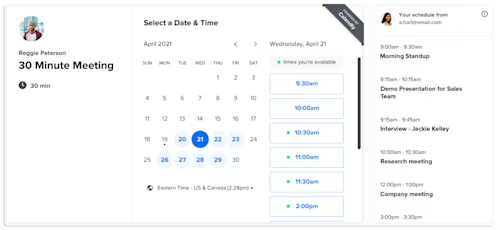
Calendly is a scheduling tool that makes it instant and effortless to book meetings. It’s a simple, focused tool that’s not trying to do everything—instead, it does one thing really well.
Once two people decide a meeting needs to happen, one person simply shares their Calendly link, which is synced in real-time with their work calendar. The Calendly calendar is shown pre-loaded with the user’s availability, so the other person can directly book a time that works well for them.
Calendly is like a helpful personal assistant, handling all that’s tedious about scheduling.
How it helps SMB productivity
Meetings are already time-consuming enough. Don’t waste even more time playing email ping-pong just to find a time that works for everyone.
Calendly eliminates at least two emails every time a meeting gets booked. Over time, those incremental gains in efficiency can really add up, keeping communication focused and saving everyone time.
Pricing
For a single user, Calendly is free. This free plan includes a customized booking link and a branded calendar page. The user can book unlimited meetings, send automated invitations and integrate with tools like Google Meet, Microsoft Teams and Zoom.
The paid plans run from $8 to $16 per user, per month. They allow for more users, more types of events and advanced analytics.
5. StreamYard for virtual meetings
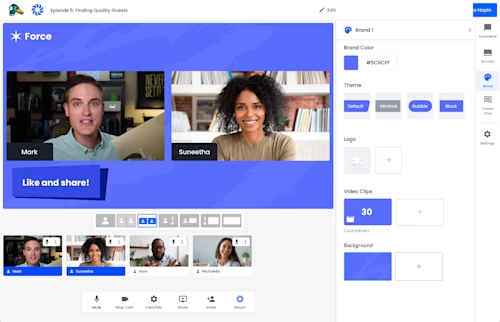
Streamyard was made for broadcasting live video content to social media or YouTube. But you don’t need to be going live to use it—it’s possibly the most underrated, fun-to-use video conferencing tool out there.
It’s easy and seamless for guests to join by visiting the host’s Streamyard studio link. In meetings, they’ll enjoy fun on-screen branding and interactive tools like live comments and likes.
Streamyard is like a decked-out virtual meeting room, for both business and fun.
How it helps SMB productivity
Meetings through Streamyard are easier—but they’re also more enjoyable!
The on-screen branding elevates the entire meeting experience and creates an opportunity to reinforce your brand. The smooth login experience also makes life easier for guests, as there’s no need to type in a login code as you would on Zoom.
Recording meetings is easy, too, so they can become a useful resource to refer to later. Finally, Streamyard works well with screen readers, making it more accessible than Zoom for any visually-impaired colleagues.
Pricing
Anyone can have access to all of Streamyard’s core features on its free plan. The free plan offers 20 hours a month of meeting time, rather than capping each meeting at 40 minutes like Zoom does. Up to six participants can join each call, and two hours of meeting time can be recorded each month.
Streamyard also offers Basic and Professional plans, at $20 or $39 per user, per month.
6. Buffer for social media scheduling
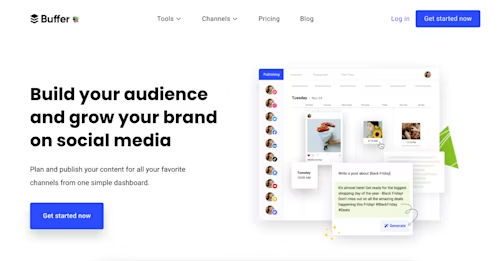
Buffer’s publishing tools allow users to draft, collaborate on and schedule social media content. Social teams (and individuals too) can publish to all of their platforms, like Facebook, TikTok and LinkedIn, from one central, monitorable dashboard.
Buffer’s engagement tools also make it much faster and easier to reply to comments and messages—no need to manually jump through platforms and open every recent post.
How it helps SMB productivity
Social media has become a normal part of business operations. Smaller brands need to stay active on social—it’s a key way to build a community, generate inbound interest, and keep in touch with customers.
However, creating and publishing content is time-consuming—especially for small and mid-sized organizations. Publishing to social media every day, let alone staying on top of engagement, can quickly overwhelm SMB marketers.
Scheduling tools like Buffer allow teams to batch out social media work into a few blocks of efficient work each week. That frees up time for other, equally important tasks.
Pricing
Get started with social media on Buffer’s free plan, which allows users to post to up to three social media channels. Users get all of Buffer’s planning and publishing tools, an AI content assistant and a landing page builder.
Scale up with the Essentials or Team plans at $6 or $12 per channel, per month.
Productivity is cheaper than you think
Giant enterprises get lots of attention, but SMBs are a critical component of our global economy. In the United States alone, nearly half of private-sector employees work for an SMB organization, and these businesses also generate 32% of known export value.
Free productivity tools, like the ones on this list, free up SMB leaders’ time. That lets them focus on creative thinking and strategic problem-solving — tasks that will truly move business forward and help them stand out in this highly competitive market.
Interested in even more free productivity tools? Another great option is Docusign eSignature. Try it for free today to see how eSignature technology can make managing SMB contracts faster and easier.
Related posts
Docusign IAM is the agreement platform your business needs


